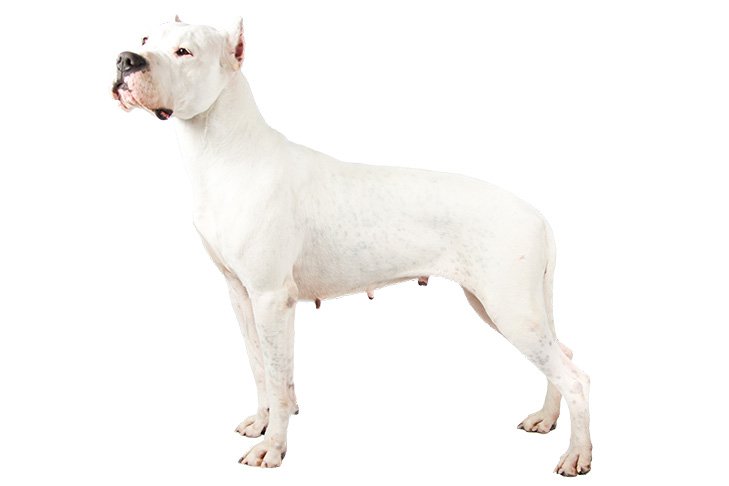Dogo Argentino
BREED INFO
- Group – Hound
- Height – 24-27 inches at the shoulder
- Weight – 36-45 KG
- Life Span – 10-12 years
The Dogo Argentino was originally bred by a doctor in Argentina for big game hunting and as a companion and protector. They are sometimes used for fighting and have gotten a bad reputation. They are banned in Britain.
History

The only dog native to Argentina, the Dogo Argentino is a fairly young breed with a colorful history. It was developed in the 1920s by an avid hunter and dog lover, Antonio Nores Martinez, with the help of his younger brother, Agustin. He wanted a dog that could track and hold large, dangerous predators, such as wild boar, jaguar and puma, while also being sufficiently stable to be a trusted family companion. Antonio started with the now-extinct Cordoba Fighting Dog, which then was a ferocious, fearless white Spanish hunter. They selectively crossed ten top-quality Cordoban bitches with hand-picked males from nine other breeds: Boxers, Bull Terriers, Dogue de Bordeaux, Great Danes, Great Pyrenees, Irish Wolfhounds, Old English Bulldogs, English Pointers, and Spanish Mastiffs . The result was a powerful, agile, intelligent dog that hunted cooperatively with other dogs with great speed and stamina and had virtually no inherent aggressive tendencies toward people or other pets.
As the Martinez brothers envisioned, the Dogo Argentino came to be a dog with tremendous endurance and hunting talent. Dogos can track a predator across vast plains, corner it and then attack and hold it in a death grip for the hunters who follow close behind. Dogos are capable of dazzling bursts of speed over short distances, but they are best at covering long distances at a rolling lope.
In 1964, the Dogo Argentino was recognized by the Cinologic Federation of Argentina and the Argentina Rural Society. The Argentina Kennel Club, a member of the Federation Cynologique International (FCI), accepted the breed in 1973. The FCI recognizes the Dogo as the first and only true Argentinean breed. The Dogo Argentino Club of America (DACA) was formed in 1985 and is the first parent club organized for the Dogo in the United States. The American Kennel Club (AKC) admitted the Dogo Argentino into its Foundation Stock Service in 1996. The United Kennel Club (UKC) recognized the Dogo Argentino in 2001, as a member of its Guardian Dog Group. The AKC moved the Dogo into its Miscellaneous Class in 2011, with a Working Dog designation. The DACA is well on its way to achieving full AKC registration status for this unique working breed.
Today, the Dogo Argentino is still used for hunting and holding large game. It hunts boar in the former Yugoslavia and moose in Canada. It is used for tracking and search and rescue. It is a talented watch dog, guard dog and police dog. Dogos are reliable guide and service dogs and compete actively in obedience and Schutzhund, both of which are sports that dog and owner participate in together. The breed continues to be popular throughout Europe, especially in Germany. Because it has shown up in illegal dog fighting rings, the Dogo Argentino has developed a bad reputation in some countries, despite its intrinsic placid nature. In the United States, breed-specific legislation varies between cities, counties and states, but some have banned the Dogo within their perimeters
Personality and Temperament
The Dogo Argentino is intelligent and trainable. They are used for police work, narcotics detection and in the military.

The Dogo Argentino is a good guard dog and is good with children living in the home. They are usually good with company, but don’t do well with other dogs.
Hair, Care and Grooming
The coat is short with no undercoat. This breed has no odor and needs infrequent bathing. They shed at an average rate.
Health
The Dogo is a fairly healthy breed, with a typical life span of between 9 and 12 years. Breed health concerns may include congenital deafness (can be unilateral or bilateral; in one or both ears), hip dysplasia, bloat/torsion (gastric dilatation and volvulus; GDV) and demodectic mange (demodex).
The primary genetic fault that “comes with” the breed, because it is a white-coated dog, is deafness. The Dogo Argentino Club of America monitors all litters whelped to DACA-registered parents. The percentage of deaf puppies is roughly 10% overall, which is the same percentage as that of the Dogo club in Germany. All Dogo Argentino puppies sold by DACA members should be accompanied by either a statement from the breeders’ veterinarian attesting to the fact that the puppy can hear, or a BAER (hearing) test report.
Training and Activity
The Dogo Argentino needs obedience training from a puppy. They need consistent, firm training and do best with owners knowledgeable about training dominant dogs.

Dogo Argentinos need exercise in a yard. They can live in an apartment, if taken for walks regularly.
Feeding
Dogo Argentinos are large dogs and should be fed two wholesome meals of high-quality dry food or canned/raw foods






